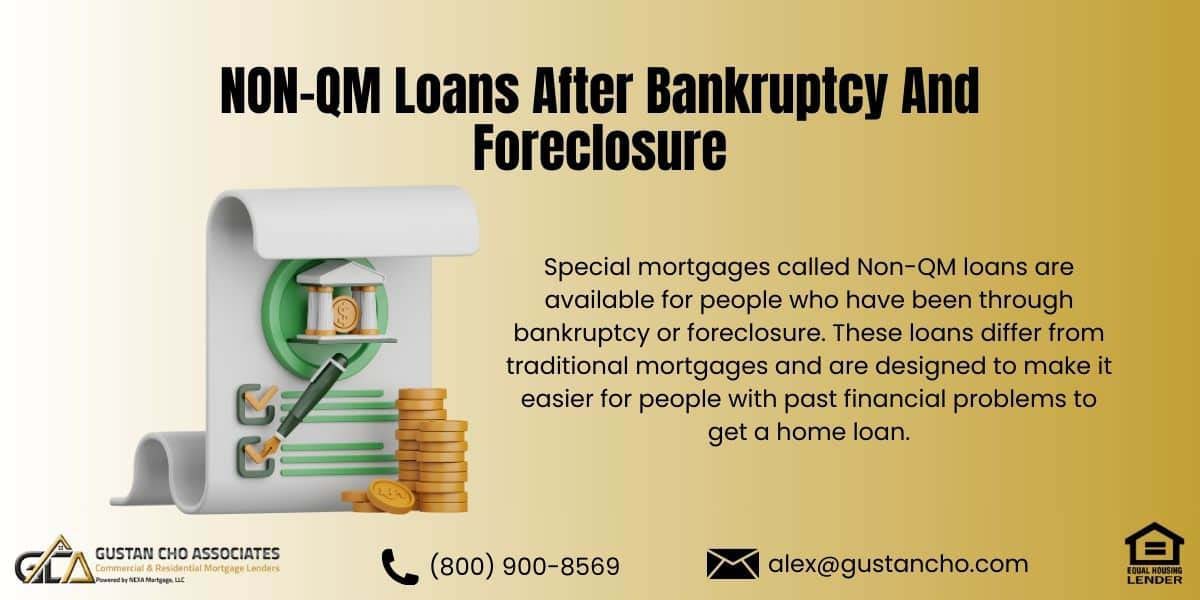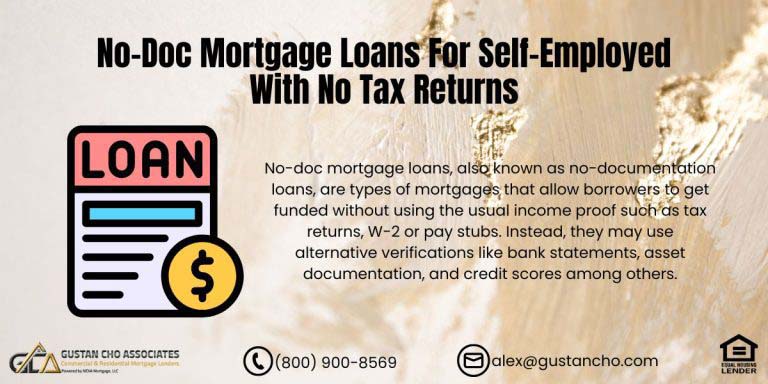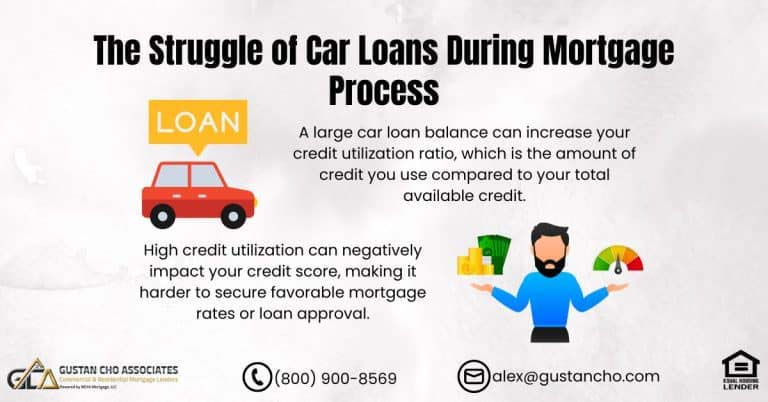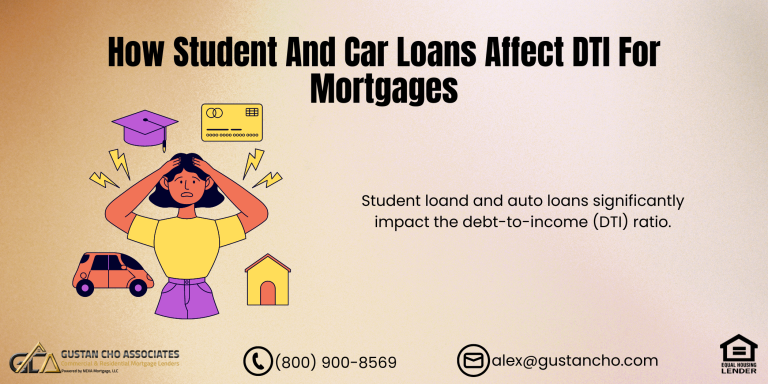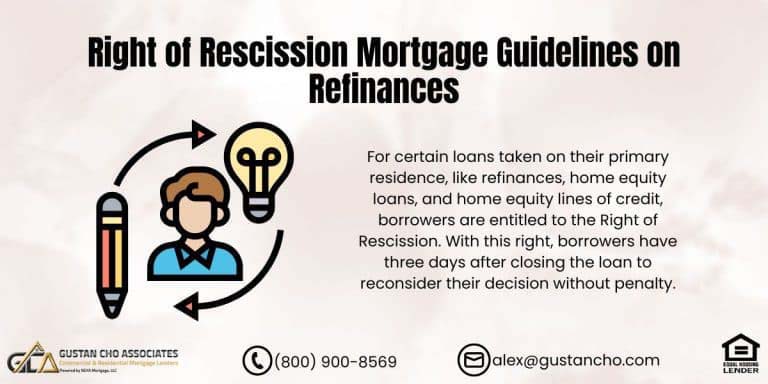Understanding mortgages can feel overwhelming, especially when you’ve been through tough financial times like bankruptcy or foreclosure. It’s common for regular banks to ask you to wait a long while before they let you think about buying a house again. But there’s great news for you! At Gustan Cho Associates, we have a special option called non-QM loans after bankruptcy and foreclosure.
This option gives you a chance to apply for a home loan without having to wait for years. In this detailed guide, we’ll take a close look at everything you need to learn about non-QM loans after bankruptcy and foreclosure and how they can help you get back on the path to owning your dream home. With our expert advice, you’ll see that achieving the goal of homeownership is still within your reach, even after facing financial hurdles.
Understanding Non-QM Loans
Understanding non-QM loans just got easier. These are special types of loans for folks who might not fit the mold of traditional mortgage loans. Non-qualified mortgage loans are all about giving people a bit more wiggle room when it comes to the harsh rules of loan approval.
They’re more relaxed about your credit score and how you prove your income, along with other usual requirements. This makes non-QM loans a fantastic choice, especially for anyone trying to get back on their feet after a bankruptcy or foreclosure. So, if you’re looking into non-QM loans after bankruptcy and foreclosure, you’re exploring an option that understands life’s ups and downs and is ready to work with you.
Bankruptcy or Foreclosure in Your Past? NON-QM Loans Can Help You Get Back on Track!
Contact us today to explore how we can help you secure financing and move forward with homeownership.
Key Features of Non-QM Loans
Here’s a more detailed and simplified look at the key advantages of non-QM loans, especially after experiences like bankruptcy and foreclosure:
- No Waiting Period: One of the standout features of non-QM loans after bankruptcy and foreclosure is that you don’t have to wait around. Unlike the usual loans that make you wait for a certain period after going through bankruptcy or foreclosure, non-QM loans allow you to apply right away. This means you can get back on your financial feet much quicker.
- Flexible Credit Requirements: These loans are also a great option for folks whose credit scores aren’t at the top. Non-QM loans after bankruptcy and foreclosure are known for their flexible credit requirements. It’s possible to qualify even with a credit score of 500, which is a relief for many.
- Alternative Income verification: Non-QM loans don’t stick to the old ways of checking income. Instead of just looking at pay stubs, they might look at your bank statements or how much you have in assets. This alternative way of verifying income is perfect for people who earn money in non-traditional ways, like freelancers or small business owners.
- Higher Debt-to-Income Ratios: For those who carry a bit more debt than our income, non-QM loans give us a shot when others might not. These lenders are okay with higher debt-to-income ratios, offering you more wiggle room when qualifying for a loan.
So, if you’re bouncing back from bankruptcy or foreclosure, non-QM loans offer a flexible and understanding path forward, allowing you to dive back into the housing market without the long wait and stringent requirements of traditional loans.
Non-QM Loans After Bankruptcy and Foreclosure
Getting back on your feet after financial mishaps is tough, but that shouldn’t stop you from dreaming about owning a home again. This is where non-QM loans after bankruptcy and foreclosure come into play. These special types of loans allow you to skip the long waiting periods you normally face with traditional or government-backed mortgages.
Why should you consider non-QM loans after bankruptcy and foreclosure? There are a bunch of good reasons.
- Waiting Period After Bankruptcy and Foreclosure: First, they let you jump back into the housing market almost immediately. That’s right – with non-QM loans after bankruptcy and foreclosure, you could qualify for a new home loan just one day after your bankruptcy or foreclosure case wraps up. This is a big deal for anyone eager to move forward.
- Competitive Rates: Even though these loans may have slightly higher interest rates than regular loans, they still offer competitive rates. What’s more, they offer a real shot at homeownership without waiting for years.
- Personalized Solutions: Lastly, these loans are all about finding a fit for you. Have you ever felt like a number in the loan process? Well, lenders specializing in non-QM loans take a different approach. They look at the whole picture – not just your past mistakes but how you’ve recovered and where you stand financially. Adding a personal touch can make a significant difference in helping you return to your own home.
The History of FHA’s Back to Work Program
Before the popularity of non-QM loans after bankruptcy and foreclosure took hold, the FHA had created something special called the Back to Work program. This program, started in 2013 by HUD, was made to help people who had gone through tough financial times. It was specifically designed for those who had faced a bankruptcy or a foreclosure.
The idea was straightforward: instead of waiting for a long time before you could apply for a new mortgage, this program would let you jump back into the housing market just one year after such a financial setback.
But it was more challenging than it sounded. The program had a lot of rules and conditions that made it quite complicated, and ultimately, it didn’t last. Despite its good intentions, the Back to Work program was discontinued. Still, it marked an important attempt to offer support through non-QM loans after bankruptcy and foreclosure.
The Pitfalls of the FHA Back to Work Program
The FHA Back to Work Program aimed to help people get back on their feet. And move into homes after financial setbacks like losing a job. However, it turned out to be trickier than many thought. Applicants had to prove that their money troubles were directly caused by big economic troubles, not just personal ones.
This rule made things confusing, and the rules were sometimes applied differently, leading to a lot of people getting their applications turned down.
On the flip side, non-QM loans after bankruptcy and foreclosure offer a simpler way for folks to become homeowners again. Unlike the FHA program, non-QM loans after bankruptcy and foreclosure don’t require borrowers to jump through as many hoops to prove their financial struggles were due to big economic events. This makes owning a home again more straightforward and less of a headache for many.
Applying for Non-QM Loans After Bankruptcy and Foreclosure
When you’re on the journey to bounce back after a tough financial period and eyeing non-QM loans after bankruptcy and foreclosure, it’s pretty much stepping into a new chapter of financing opportunities. Here’s the scoop on what you should expect during the application process.
Key points to understand:
- Your Credit Score: Non-QM loans after bankruptcy and foreclosure are friendlier. You don’t need sky-high credit scores to apply. In fact, you could have a score as low as 500 and still be in the game.
- The Down Payment: Non-QM loans after bankruptcy and foreclosure often require a pretty penny upfront. We’re talking about a down payment of around 30% of the loan amount. It’s a way to show lenders you’re serious and helps lower their risk.
- Proving Your Income: Since your financial history has a few bumps, lenders will want to see that you have a stable income now. Don’t sweat if your job doesn’t give you standard paycheck stubs. You can use other proofs like your bank statements or assets you own to show you can pay the loan back.
This whole process is about showing that, despite past hurdles, you can take on a loan responsibly now. Keep these points in mind as you prepare your application, and you’ll navigate the process of applying for non-QM loans after bankruptcy and foreclosure much more smoothly.
Looking to Buy After Bankruptcy or Foreclosure? NON-QM Loans Offer Flexible Solutions!
Reach out now to discuss your options and get back on the path to homeownership.
Applying for Non-QM Loans: Step-by-Step Guide
If you’re worried about your credit history, specifically if you’ve experienced bankruptcy or foreclosure, there’s an option you might not have considered yet. Non-QM loans after bankruptcy and foreclosure are designed for people just like you. Here’s a straightforward guide on how to go about applying:
- Contact a Lender: First, find a lender who handles non-QM loans after bankruptcy and foreclosure. At Gustan Cho Associates, we’re well-versed in these kinds of loans and have helped many borrowers in situations similar to yours.
- Gather Documentation: Next, you’ll want to start gathering all the essential paperwork. This includes any documentation that proves your income, a detailed breakdown of your credit history, and specifics about your bankruptcy or foreclosure. Having these documents ready will help speed up the process and make it more efficient.
- Submit Application: Once you have all your documents in order, it’s time to fill out the application. Your chosen lender will examine your financial details, including your income, credit score, and past financial challenges, to determine if you qualify for a loan.
- Get Pre-Approved: If everything checks out and you meet the lender’s criteria, the next step is getting pre-approved. This pre-approval is significant because it gives you a clear idea of how much you can borrow. This will help you confidently search for homes within your budget, knowing exactly what you can afford.
Securing a non-QM loan after bankruptcy or foreclosure can feel daunting. Yet, with the right guidance and preparation, it’s feasible to regain homeownership.
Benefits of Non-QM Loans
Non-QM loans after bankruptcy and foreclosure come with a bunch of perks that can really make a difference for folks starting fresh.
Immediate Homeownership Opportunities
What’s great about non-QM loans after bankruptcy and foreclosure is that they make you buy a home quickly. This means you can jump into the housing market when ready, grabbing that dream home much quicker than you thought possible.
Flexible Underwriting
One of the biggest advantages of non-QM loans after bankruptcy and foreclosure is how they look at your whole money story—not just a number like your credit score. This way, if you’ve been getting yourself back on track, there’s a better chance you’ll qualify.
No Loan Limits
Also, you don’t have to worry about bumping your head on the ceiling with how much you can borrow. Non-QM loans after bankruptcy and foreclosure don’t have the limits traditional loans have. This is super handy if your eyes are set on a home that’s on the pricier side.
All in all, these loans are a solid option for anyone looking to get back into homeownership without the long wait or the tight restrictions.
Improving Your Chances of Approval
Improving your chances of getting approved for non-QM loans after bankruptcy and foreclosure is challenging. Still, there are straightforward steps you can follow to increase your chances of getting approved. Here’s what you can do:
Rebuild Your Credit
First, focus on rebuilding your credit. Non-QM loans after bankruptcy and foreclosure are indeed designed for folks who might not have the highest credit scores. However, by working on improving your credit, you’re not only increasing your chances of approval but also potentially getting better loan conditions. You can do this by paying your bills on time, lowering your overall debt, and considering secured credit cards to help build a stronger credit history.
Save for Down Payment
Next up, saving for a down payment is crucial. Having a larger down payment doesn’t just boost your likelihood of getting approved; it also puts you in a better position to negotiate the terms of your loan. Ideally, aim to save at least 30% of the price of the home you’re looking to buy. This shows lenders that you’re serious and financially prepared for this commitment.
Document Your Income
Don’t forget to keep a good record of your income. Since non-QM lenders use unconventional ways to check your income, having clear and detailed documentation is essential. This includes keeping up-to-date bank statements, records of any investments, and evidence of other financial resources. The better you can demonstrate your financial stability, the higher your chances of approval for non-QM loans after bankruptcy and foreclosure.
Work with Experienced Lenders
Lastly, working with lenders who know their way around non-QM loans can make a big difference. Opt for lenders with a solid track record of assisting borrowers bouncing back from financial setbacks like bankruptcy or foreclosure. At Gustan Cho Associates, our team is committed to guiding you through securing the loan you need, drawing from our extensive experience with non-QM loans after bankruptcy and foreclosure.
Taking these measures to heart and applying them to your strategy can substantially elevate your prospects of obtaining a non-QM loan, even with past bankruptcy or foreclosure.
Non-QM Loans: A Great Option After Bankruptcy or Foreclosure!
Contact us today to see how we can help you secure financing with flexible terms.
The Future of Non-QM Loans after Bankruptcy and Foreclosure
In today’s ever-changing housing market, the role of non-QM loans after bankruptcy and foreclosure is becoming increasingly important. These loans are like a beacon of hope for individuals who have gone through tough financial times, offering them a much-needed second shot at buying a home.
Adapting to Market Changes
Lenders specializing in non-QM loans are always looking for ways to better serve their customers. This means developing innovative loan options, offering competitive interest rates that are hard to pass up, and making the application process as hassle-free as possible.
Creating More Home-Buying Opportunities
Thanks to the absence of strict borrowing limits and more forgiving eligibility requirements, non-QM loans continue to open doors for more and more prospective homeowners. If you work for yourself, have a fluctuating income, or have recently recovered from financial difficulties, non-QM loans following bankruptcy and foreclosure can help you achieve your goal of owning a home.
Non-QM loans after bankruptcy and foreclosure offer a valuable opportunity for individuals looking to re-enter the housing market. With flexible criteria, no waiting periods, and a focus on your overall financial picture, these loans provide a practical solution for those who have faced financial setbacks. At Gustan Cho Associates, we are committed to assisting you throughout the process and achieving your homeownership goals.
FAQs: NON-QM Loans After Bankruptcy And Foreclosure
- 1. What are non-QM loans after bankruptcy and foreclosure? Special mortgages called Non-QM loans are available for people who have been through bankruptcy or foreclosure. These loans differ from traditional mortgages and are designed to make it easier for people with past financial problems to get a home loan.
- 2. How soon can I apply for a non-QM loan after bankruptcy or foreclosure? You can apply right after your bankruptcy discharge or foreclosure completion. There’s no waiting period, unlike traditional loans, which usually require several years of waiting.
- 3. What are the down payment requirements for non-QM loans after bankruptcy and foreclosure? Typically, you’ll need a 30% down payment for Non-QM loans after bankruptcy and foreclosure. This higher down payment shows lenders you’re serious about buying a home and helps reduce risk.
- 4. Do non-QM loans after bankruptcy and foreclosure have higher interest rates? Yes, non-QM loans often have higher interest rates than traditional loans. However, they offer the benefit of immediate qualification and flexibility for those who have faced financial setbacks.
- 5. Can I qualify for a non-QM loan with a low credit score? Yes, you can qualify for a Non-QM loan even with a low credit score, sometimes as low as 500. These loans are designed to help borrowers with less-than-perfect credit histories.
- 6. What documents do I need to apply for non-QM loans after bankruptcy and foreclosure? You’ll need to provide alternative income verification, such as bank statements, proof of assets, and details about your bankruptcy or foreclosure. Each lender may have slightly different requirements.
- 7. Are there loan limits on non-QM loans after bankruptcy and foreclosure? Non-QM loans often don’t have maximum loan limits, making them a good option if you’re looking to buy a higher-priced home.
- 8. How do non-QM loans differ from traditional mortgages? Non-QM loans are different from traditional mortgages. They are more flexible with credit scores, income verification, and debt-to-income ratios, making them available to borrowers who have faced financial challenges.
- 9. What is the application process for non-QM loans after bankruptcy and foreclosure? The process involves contacting a lender, gathering necessary documents, submitting an application, and possibly getting pre-approved. At Gustan Cho Associates, we guide you through each step to make it as smooth as possible.
- 10. Why should I choose a Non-QM loan after bankruptcy and foreclosure? Non-QM loans offer immediate qualification, flexible requirements, and no waiting periods. They’re an excellent option if you’ve recovered from bankruptcy or foreclosure and are ready to buy a home without waiting for years.
For more information or to apply for non-QM loans after bankruptcy and foreclosure, contact us at 800-900-8569, text us for a faster response, or email us at gcho@gustancho.com. Our team is available to assist you seven days a week, including evenings and weekends. Let us help you find a home with non-QM loans after bankruptcy and foreclosure.
This blog about NON-QM Loans After Bankruptcy And Foreclosure was updated on July 19th, 2024.
Ready to Buy After Bankruptcy or Foreclosure? NON-QM Loans Make Homeownership Possible!
Reach out today to learn more about how we can help you qualify for a mortgage.


